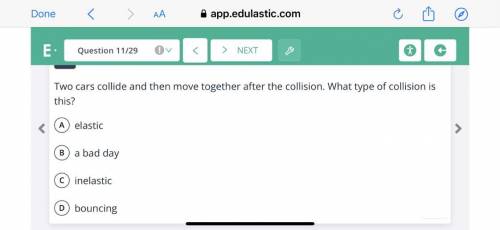Two cars collide and then move together after the collision. What type of collision is this?
...

Physics, 16.12.2021 20:10 duplessistoccara
Two cars collide and then move together after the collision. What type of collision is this?


Answers: 3


Other questions on the subject: Physics

Physics, 21.06.2019 17:20, gymer630
American eels (anguilla rostrata) are freshwater fish with long, slender bodies that we can treat as uniform cylinders 1.0 m long and 10 cm in diameter. an eel compensates for its small jaw and teeth by holding onto prey with its mouth and then rapidly spinning its body around its long axis to tear off a piece of flesh. eels have been recorded to spin at up to 14 revolutions per second when feeding in this way. although this feeding method is costly in terms of energy, it allows the eel to feed on larger prey than it otherwise could. 1.a field researcher uses the slow-motion feature on her phones camera to shoot a video of an eel spinning at its maximum rate. the camera records at 120 frames per second. through what angle does the eel rotate from one frame to the next? 2. the eel is observed to spin at 14 spins per second clockwise, and 10 seconds later it is observed to spin at 8 spins per second counterclockwise. what is the magnitude of the eels average angular acceleration during this time? 3. the eel has a certain amount of rotational kinetic energy when spinning at 14 spins per second. if it swam in a straight line instead, about how fast would the eel have to swim to have the same amount of kinetic energy as when it is spinning? 4.a new species of eel is found to have the same mass but one-quarter the length and twice the diameter of the american eel. how does its moment of inertia for spinning around its long axis compare to that of the american eel?
Answers: 1

Physics, 21.06.2019 21:30, XCNajera2003
Look at the potential energy diagram for a chemical reaction. which statement correctly describes the energy changes that occur in the forward reaction?
Answers: 2

Physics, 22.06.2019 01:40, sasalinas2001
In all trials, the magnitude of the final velocity for g1 + g2 was less than the magnitude of any initial velocity. as mass increased, what happened to the velocity? the velocity decreased. the velocity increased. the velocity of g1 + g2 could not be measured. the velocity was not affected by the mass increase.
Answers: 1

Physics, 22.06.2019 10:30, jdkrisdaimcc11
What are two different ways you could find the value of a? explain these methods.
Answers: 2
You know the right answer?
Questions in other subjects:

History, 02.10.2020 23:01


Mathematics, 02.10.2020 23:01


Advanced Placement (AP), 02.10.2020 23:01

Health, 02.10.2020 23:01


English, 02.10.2020 23:01

Chemistry, 02.10.2020 23:01

Mathematics, 02.10.2020 23:01



